3com NBX 100, SS3 NBX Service Manual
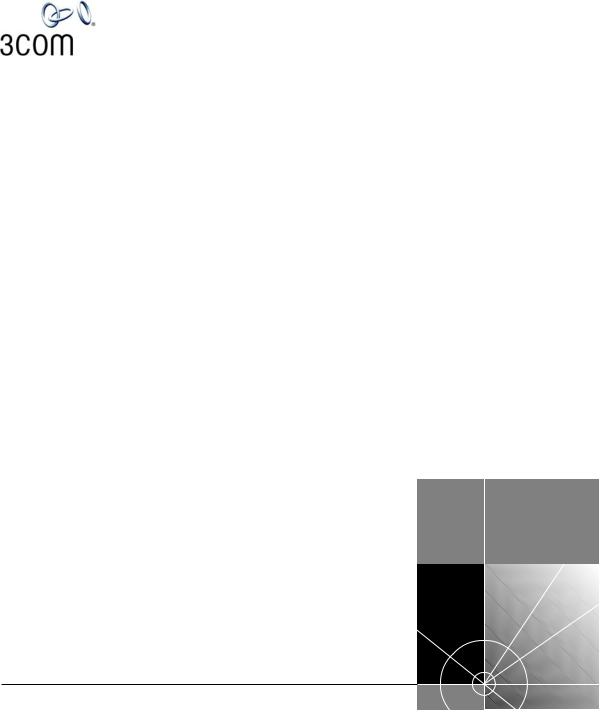
NBX® Installation Guide
Release 4.3
■SuperStack 3 NBX
■NBX 100
http://www.3com.com/
Part No. 900-0155-01
Published June 2004
3Com Corporation 350 Campus Drive Marlborough, MA 01752-3064
Copyright © 2004, 3Com Corporation. All rights reserved. No part of this documentation may be reproduced in any form or by any means or used to make any derivative work (such as translation, transformation, or adaptation) without written permission from 3Com Corporation.
3Com Corporation reserves the right to revise this documentation and to make changes in content from time to time without obligation on the part of 3Com Corporation to provide notification of such revision or change.
3Com Corporation provides this documentation without warranty, term, or condition of any kind, either implied or expressed, including, but not limited to, the implied warranties, terms, or conditions of merchantability, satisfactory quality, and fitness for a particular purpose. 3Com may make improvements or changes in the product(s) and/or the program(s) described in this documentation at any time.
If there is any software on removable media described in this documentation, it is furnished under a license agreement included with the product as a separate document, in the hardcopy documentation, or on the removable media in a directory file named LICENSE.TXT or !LICENSE.TXT. If you are unable to locate a copy, please contact 3Com and a copy will be provided to you.
UNITED STATES GOVERNMENT LEGEND
If you are a United States government agency, then this documentation and the software described herein are provided to you subject to the following:
All technical data and computer software are commercial in nature and developed solely at private expense. Software is delivered as “Commercial Computer Software” as defined in DFARS 252.227-7014 (June 1995) or as a “commercial item” as defined in FAR 2.101(a) and as such is provided with only such rights as are provided in 3Com’s standard commercial license for the Software. Technical data is provided with limited rights only as provided in DFAR 252.227-7015 (Nov 1995) or FAR 52.227-14 (June 1987), whichever is applicable. You agree not to remove or deface any portion of any legend provided on any licensed program or documentation contained in, or delivered to you in conjunction with, this guide.
_______________________________________________________________________
PATENT INFORMATION
NBX Telephones 3C10281PE, 3C10226PE, 3C10228IRPE, and 3C10248PE are covered by one or more of the following U.S. patents and other patent applications pending:
5,994,998; 6,140,911; 6,329,906; 6,496,105; 6,535,983; 6,483,203; 6,449,348; 6,212,195
_______________________________________________________________________
TRADEMARKS
Unless otherwise indicated, 3Com registered trademarks are registered in the United States and may or may not be registered in other countries. 3Com, NBX, the 3Com logo, and SuperStack are registered trademarks of 3Com Corporation. NBX NetSet and pcXset are trademarks of 3Com Corporation.
Adobe is a trademark and Adobe Acrobat is a registered trademark of Adobe Systems Incorporated. InstallShield is a registered trademark of InstallShield Software Corporation. Internet Explorer, Microsoft, Windows, Windows 2000, and Windows NT are registered trademarks of Microsoft Corporation. Netscape and Netscape Navigator are registered trademarks of Netscape Communication Corporation in the United States and other countries. All other company and product names may be trademarks of the respective companies with which they are associated.
_______________________________________________________________________
TECHNOLOGY ACKNOWLEDGEMENTS
_______________________________________________________________________
RSA Data Security, Inc. MD5 Message-Digest Algorithm
Copyright © 1991-2, RSA Data Security, Inc. Created 1991. All rights reserved.
License to copy and use this software is granted provided that it is identified as the “RSA Data Security, Inc. MD5 Message-Digest Algorithm” in all material mentioning or referencing this software or this function.
License is also granted to make and use derivative works provided that such works are identified as “derived from the RSA Data Security, Inc. MD5 Message-Digest Algorithm” in all material mentioning or referencing the derived work.
RSA Data Security, Inc. makes no representations concerning either the merchantability of this software or the suitability of this software for any particular purpose. It is provided “as is” without express or implied warranty of any kind.
These notices must be retained in any copies of any part of this documentation and/or software.
_________________________________________________________________________________
libtar 2.1.11
Copyright © 1998-2003 University of Illinois Board of Trustees
Copyright © 1998-2003 Mark D. Roth
All rights reserved.
Developed by:
Campus Information Technologies and Educational Services, University of Illinois at Urbana-Champaign
Permission is hereby granted, free of charge, to any person obtaining a copy of this software and associated documentation files (the “Software”), to deal with the Software without restriction, including without limitation the rights to use, copy, modify, merge, publish, distribute, sublicense, and/or sell copies of the Software, and to permit persons to whom the Software is furnished to do so, subject to the following conditions:
■Redistributions of source code must retain the above copyright notice, this list of conditions and the following disclaimers.
■Redistributions in binary form must reproduce the above copyright notice, this list of conditions and the following disclaimers in the documentation and/or other materials provided with the distribution.
■Neither the names of Campus Information Technologies and Educational Services, University of Illinois at Urbana-Champaign, nor the names of its contributors may be used to endorse or promote products derived from this Software without specific prior written permission.
THE SOFTWARE IS PROVIDED “AS IS,” WITHOUT WARRANTY OF ANY KIND, EXPRESS OR IMPLIED, INCLUDING BUT NOT LIMITED TO THE WARRANTIES OF MERCHANTABILITY, FITNESS FOR A PARTICULAR PURPOSE AND NONINFRINGEMENT. IN NO EVENT SHALL THE CONTRIBUTORS OR COPYRIGHT HOLDERS BE LIABLE FOR ANY CLAIM, DAMAGES, OR OTHER LIABILITY, WHETHER IN AN ACTION OF CONTRACT, TORT, OR OTHERWISE, ARISING FROM, OUT OF, OR IN CONNECTION WITH THE SOFTWARE OR THE USE OR OTHER DEALINGS WITH THE SOFTWARE.
_________________________________________________________________________________
OpenBSD: basename.c,v 1.4 1999/05/30 17:10:30 espie Exp
OpenBSD: dirname.c,v 1.4 1999/05/30 17:10:30 espie Exp
Copyright © 1997 Todd C. Miller <Todd.Miller@courtesan.com> All rights reserved.
Redistribution and use in source and binary forms, with or without modification, are permitted provided that the following conditions are met:
1.Redistributions of source code must retain the above copyright notice, this list of conditions and the following disclaimer.
2.Redistributions in binary form must reproduce the above copyright notice, this list of conditions and the following disclaimer in the documentation and/or other materials provided with the distribution.
3.The name of the author may not be used to endorse or promote products derived from this software without specific prior written permission.
THIS SOFTWARE IS PROVIDED “AS IS” AND ANY EXPRESS OR IMPLIED WARRANTIES, INCLUDING, BUT NOT LIMITED TO, THE IMPLIED WARRANTIES OF MERCHANTABILITY AND FITNESS FOR A PARTICULAR PURPOSE ARE DISCLAIMED. IN NO EVENT SHALL THE AUTHOR BE LIABLE FOR ANY DIRECT, INDIRECT, INCIDENTAL, SPECIAL, EXEMPLARY, OR CONSEQUENTIAL DAMAGES (INCLUDING, BUT NOT LIMITED TO, PROCUREMENT OF SUBSTITUTE GOODS OR SERVICES; LOSS OF USE, DATA, OR PROFITS; OR BUSINESS INTERRUPTION) HOWEVER CAUSED AND ON ANY THEORY OF LIABILITY, WHETHER IN CONTRACT, STRICT LIABILITY, OR TORT (INCLUDING NEGLIGENCE OR OTHERWISE) ARISING IN ANY WAY OUT OF THE USE OF THIS SOFTWARE, EVEN IF ADVISED OF THE POSSIBILITY OF SUCH DAMAGE.
_________________________________________________________________________________
OpenBSD: fnmatch.c,v 1.6 1998/03/19 00:29:59 millert Exp
Copyright © 1989, 1993, 1994 The Regents of the University of California. All rights reserved.
This code is derived from software contributed to Berkeley by Guido van Rossum.
Redistribution and use in source and binary forms, with or without modification, are permitted provided that the following conditions are met:
1. Redistributions of source code must retain the above copyright notice, this list of conditions and the following disclaimer.
2.Redistributions in binary form must reproduce the above copyright notice, this list of conditions and the following disclaimer in the documentation and/or other materials provided with the distribution.
3.All advertising materials mentioning features or use of this software must display the following acknowledgement:
This product includes software developed by the University of California, Berkeley and its contributors.
4. Neither the name of the University nor the names of its contributors may be used to endorse or promote products derived from this software without specific prior written permission.
THIS SOFTWARE IS PROVIDED BY THE REGENTS AND CONTRIBUTORS ``AS IS'' AND ANY EXPRESS OR IMPLIED WARRANTIES, INCLUDING, BUT NOT LIMITED TO, THE IMPLIED WARRANTIES OF MERCHANTABILITY AND FITNESS FOR A PARTICULAR PURPOSE ARE DISCLAIMED. IN NO EVENT SHALL THE REGENTS OR CONTRIBUTORS BE LIABLE FOR ANY DIRECT, INDIRECT, INCIDENTAL, SPECIAL, EXEMPLARY, OR CONSEQUENTIAL DAMAGES (INCLUDING, BUT NOT LIMITED TO, PROCUREMENT OF SUBSTITUTE GOODS OR SERVICES; LOSS OF USE, DATA, OR PROFITS; OR BUSINESS INTERRUPTION) HOWEVER CAUSED AND ON ANY THEORY OF LIABILITY, WHETHER IN CONTRACT, STRICT LIABILITY, OR TORT (INCLUDING NEGLIGENCE OR OTHERWISE) ARISING IN ANY WAY OUT OF THE USE OF THIS SOFTWARE, EVEN IF ADVISED OF THE POSSIBILITY OF SUCH DAMAGE.
_________________________________________________________________________________
gethostname.c: minimal substitute for missing gethostname() function
created 2000-Mar-02 jmk
requires SVR4 uname() and -lc
by Jim Knoble <jmknoble@pobox.com>
Copyright © 2000 Jim Knoble
Permission to use, copy, modify, distribute, and sell this software and its documentation for any purpose is hereby granted without fee, provided that the above copyright notice appear in all copies and that both that copyright notice and this permission notice appear in supporting documentation.
This software is provided “as is,” without warranty of any kind, express or implied, including but not limited to the warranties of merchantability, fitness for a particular purpose and noninfringement. In no event shall the author(s) be liable for any claim, damages or other liability, whether in an action of contract, tort or otherwise, arising from, out of or in connection with the software or the use or other dealings in the software.
_________________________________________________________________________________
glob.c
Copyright © 1989, 1993
The Regents of the University of California. All rights reserved.
This code is derived from software contributed to Berkeley by Guido van Rossum.
Redistribution and use in source and binary forms, with or without modification, are permitted provided that the following conditions are met:
1.Redistributions of source code must retain the above copyright notice, this list of conditions and the following disclaimer.
2.Redistributions in binary form must reproduce the above copyright notice, this list of conditions and the following disclaimer in the documentation and/or other materials provided with the distribution.
3.All advertising materials mentioning features or use of this software must display the following acknowledgement:
This product includes software developed by the University of California, Berkeley and its contributors.
4. Neither the name of the University nor the names of its contributors may be used to endorse or promote products derived from this software without specific prior written permission.
THIS SOFTWARE IS PROVIDED BY THE REGENTS AND CONTRIBUTORS ``AS IS'' AND ANY EXPRESS OR IMPLIED WARRANTIES, INCLUDING, BUT NOT LIMITED TO, THE IMPLIED WARRANTIES OF MERCHANTABILITY AND FITNESS FOR A PARTICULAR PURPOSE ARE DISCLAIMED. IN NO EVENT SHALL THE REGENTS OR CONTRIBUTORS BE LIABLE FOR ANY DIRECT, INDIRECT, INCIDENTAL, SPECIAL, EXEMPLARY, OR CONSEQUENTIAL DAMAGES (INCLUDING, BUT NOT LIMITED TO, PROCUREMENT OF SUBSTITUTE GOODS OR SERVICES; LOSS OF USE, DATA, OR PROFITS; OR BUSINESS INTERRUPTION) HOWEVER CAUSED AND ON ANY THEORY OF LIABILITY, WHETHER IN CONTRACT, STRICT LIABILITY, OR TORT (INCLUDING NEGLIGENCE OR OTHERWISE) ARISING IN ANY WAY OUT OF THE USE OF THIS SOFTWARE, EVEN IF ADVISED OF THE POSSIBILITY OF SUCH DAMAGE.
_________________________________________________________________________________
OpenBSD: strdup.c,v 1.3 1997/08/20 04:18:52 millert Exp
Copyright © 1988, 1993
The Regents of the University of California. All rights reserved.
Redistribution and use in source and binary forms, with or without modification, are permitted provided that the following conditions are met:
1.Redistributions of source code must retain the above copyright notice, this list of conditions and the following disclaimer.
2.Redistributions in binary form must reproduce the above copyright notice, this list of conditions and the following disclaimer in the documentation and/or other materials provided with the distribution.
3.All advertising materials mentioning features or use of this software must display the following acknowledgement:
This product includes software developed by the University of California, Berkeley and its contributors.
4. Neither the name of the University nor the names of its contributors may be used to endorse or promote products derived from this software without specific prior written permission.
THIS SOFTWARE IS PROVIDED BY THE REGENTS AND CONTRIBUTORS “AS IS” AND ANY EXPRESS OR IMPLIED WARRANTIES, INCLUDING, BUT NOT LIMITED TO, THE IMPLIED WARRANTIES OF MERCHANTABILITY AND FITNESS FOR A PARTICULAR PURPOSE ARE DISCLAIMED. IN NO EVENT SHALL THE REGENTS OR CONTRIBUTORS BE LIABLE FOR ANY DIRECT, INDIRECT, INCIDENTAL, SPECIAL, EXEMPLARY, OR CONSEQUENTIAL DAMAGES (INCLUDING, BUT NOT LIMITED TO, PROCUREMENT OF SUBSTITUTE GOODS OR SERVICES; LOSS OF USE, DATA, OR PROFITS; OR BUSINESS INTERRUPTION) HOWEVER CAUSED AND ON ANY THEORY OF LIABILITY, WHETHER IN CONTRACT, STRICT LIABILITY, OR TORT (INCLUDING NEGLIGENCE OR OTHERWISE) ARISING IN ANY WAY OUT OF THE USE OF THIS SOFTWARE, EVEN IF ADVISED OF THE POSSIBILITY OF SUCH DAMAGE.
_________________________________________________________________________________
OpenBSD: strlcat.c,v 1.5 2001/01/13 16:17:24 millert Exp
OpenBSD: strlcpy.c,v 1.4 1999/05/01 18:56:41 millert Exp
Copyright © 1998 Todd C. Miller <Todd.Miller@courtesan.com>
All rights reserved.
Redistribution and use in source and binary forms, with or without modification, are permitted provided that the following conditions are met:
1.Redistributions of source code must retain the above copyright notice, this list of conditions and the following disclaimer.
2.Redistributions in binary form must reproduce the above copyright notice, this list of conditions and the following disclaimer in the documentation and/or other materials provided with the distribution.
3.The name of the author may not be used to endorse or promote products derived from this software without specific prior written permission.
THIS SOFTWARE IS PROVIDED ``AS IS'' AND ANY EXPRESS OR IMPLIED WARRANTIES, INCLUDING, BUT NOT LIMITED TO, THE IMPLIED WARRANTIES OF MERCHANTABILITY AND FITNESS FOR A PARTICULAR PURPOSE ARE DISCLAIMED. IN NO EVENT SHALL THE AUTHOR BE LIABLE FOR ANY DIRECT, INDIRECT, INCIDENTAL, SPECIAL, EXEMPLARY, OR CONSEQUENTIAL DAMAGES (INCLUDING, BUT NOT LIMITED TO, PROCUREMENT OF SUBSTITUTE GOODS OR SERVICES; LOSS OF USE, DATA, OR PROFITS; OR BUSINESS INTERRUPTION) HOWEVER CAUSED AND ON ANY THEORY OF LIABILITY, WHETHER IN CONTRACT, STRICT LIABILITY, OR TORT (INCLUDING NEGLIGENCE OR OTHERWISE) ARISING IN ANY WAY OUT OF THE USE OF THIS SOFTWARE, EVEN IF ADVISED OF THE POSSIBILITY OF SUCH DAMAGE.
_________________________________________________________________________________
strmode.c
Copyright © 1990 The Regents of the University of California.
All rights reserved.
Redistribution and use in source and binary forms, with or without modification, are permitted provided that the following conditions are met:
1.Redistributions of source code must retain the above copyright notice, this list of conditions and the following disclaimer.
2.Redistributions in binary form must reproduce the above copyright notice, this list of conditions and the following disclaimer in the documentation and/or other materials provided with the distribution.
3.All advertising materials mentioning features or use of this software must display the following acknowledgement:
This product includes software developed by the University of California, Berkeley and its contributors.
4. Neither the name of the University nor the names of its contributors may be used to endorse or promote products derived from this software without specific prior written permission.
THIS SOFTWARE IS PROVIDED BY THE REGENTS AND CONTRIBUTORS ``AS IS'' AND ANY EXPRESS OR IMPLIED WARRANTIES, INCLUDING, BUT NOT LIMITED TO, THE IMPLIED WARRANTIES OF MERCHANTABILITY AND FITNESS FOR A PARTICULAR PURPOSE ARE DISCLAIMED. IN NO EVENT SHALL THE REGENTS OR CONTRIBUTORS BE LIABLE FOR ANY DIRECT, INDIRECT, INCIDENTAL, SPECIAL, EXEMPLARY, OR CONSEQUENTIAL DAMAGES (INCLUDING, BUT NOT LIMITED TO, PROCUREMENT OF SUBSTITUTE GOODS OR SERVICES; LOSS OF USE, DATA, OR PROFITS; OR BUSINESS INTERRUPTION) HOWEVER CAUSED AND ON ANY THEORY OF LIABILITY, WHETHER IN CONTRACT, STRICT LIABILITY, OR TORT (INCLUDING NEGLIGENCE OR OTHERWISE) ARISING IN ANY WAY OUT OF THE USE OF THIS SOFTWARE, EVEN IF ADVISED OF THE POSSIBILITY OF SUCH DAMAGE.
_________________________________________________________________________________
OpenBSD: strsep.c,v 1.3 1997/08/20 04:28:14 millert Exp
Copyright © 1990, 1993
The Regents of the University of California. All rights reserved.
Redistribution and use in source and binary forms, with or without modification, are permitted provided that the following conditions are met:
1.Redistributions of source code must retain the above copyright notice, this list of conditions and the following disclaimer.
2.Redistributions in binary form must reproduce the above copyright notice, this list of conditions and the following disclaimer in the documentation and/or other materials provided with the distribution.
3.All advertising materials mentioning features or use of this software must display the following acknowledgement:
This product includes software developed by the University of California, Berkeley and its contributors.
4. Neither the name of the University nor the names of its contributors may be used to endorse or promote products derived from this software without specific prior written permission.
THIS SOFTWARE IS PROVIDED BY THE REGENTS AND CONTRIBUTORS “AS IS” AND ANY EXPRESS OR IMPLIED WARRANTIES, INCLUDING, BUT NOT LIMITED TO, THE IMPLIED WARRANTIES OF MERCHANTABILITY AND FITNESS FOR A PARTICULAR PURPOSE ARE DISCLAIMED. IN NO EVENT SHALL THE REGENTS OR CONTRIBUTORS BE LIABLE FOR ANY DIRECT, INDIRECT, INCIDENTAL, SPECIAL, EXEMPLARY, OR CONSEQUENTIAL DAMAGES (INCLUDING, BUT NOT LIMITED TO, PROCUREMENT OF SUBSTITUTE GOODS OR SERVICES; LOSS OF USE, DATA, OR PROFITS; OR BUSINESS INTERRUPTION) HOWEVER CAUSED AND ON ANY THEORY OF LIABILITY, WHETHER IN CONTRACT, STRICT LIABILITY, OR TORT (INCLUDING NEGLIGENCE OR OTHERWISE) ARISING IN ANY WAY OUT OF THE USE OF THIS SOFTWARE, EVEN IF ADVISED OF THE POSSIBILITY OF SUCH DAMAGE.
_________________________________________________________________________________
zlib.h — Interface of the “zlib” general-purpose compression library, version 1.1.4, March 11th, 2002
Copyright © 1995-2002 Jean-loup Gailly and Mark Adler
This software is provided “as-is”, without any express or implied warranty. In no event will the authors be held liable for any damages arising from the use of this software.
Permission is granted to anyone to use this software for any purpose, including commercial applications, and to alter it and redistribute it freely, subject to the following restrictions:
1.The origin of this software must not be misrepresented; you must not claim that you wrote the original software. If you use this software in a product, an acknowledgment in the product documentation would be appreciated but is not required.
2.Altered source versions must be plainly marked as such, and must not be misrepresented as being the original software.
3.This notice may not be removed or altered from any source distribution.
—Jean-loup Gailly jloup@gzip.org
—Mark Adler madler@alumni.caltech.edu
_________________________________________________________________________________
imapproxy
© Copyright 1993, 1994 by Carnegie Mellon University. All Rights Reserved.
Permission to use, copy, modify, distribute, and sell this software and its documentation for any purpose is hereby granted without fee, provided that the above copyright notice appear in all copies and that both that copyright notice and this permission notice appear in supporting documentation, and that the name of Carnegie Mellon University not be used in advertising or publicity pertaining to distribution of the software without specific, written prior permission. Carnegie Mellon University makes no representations about the suitability of this software for any purpose. It is provided “as is” without express or implied warranty.
CARNEGIE MELLON UNIVERSITY DISCLAIMS ALL WARRANTIES WITH REGARD TO THIS SOFTWARE, INCLUDING ALL IMPLIED WARRANTIES OF MERCHANTABILITY AND FITNESS, IN NO EVENT SHALL CARNEGIE MELLON UNIVERSITY BE LIABLE FOR ANY SPECIAL, INDIRECT, OR CONSEQUENTIAL DAMAGES OR ANY DAMAGES WHATSOEVER RESULTING FROM LOSS OF USE, DATA, OR PROFITS, WHETHER IN AN ACTION OF CONTRACT, NEGLIGENCE, OR OTHER TORTUOUS ACTION, ARISING OUT OF OR IN CONNECTION WITH THE USE OR PERFORMANCE OF THIS SOFTWARE.
_________________________________________________________________________________
imap daemon
Program: IMAP4rev1 server
Author: Mark Crispin
Networks and Distributed Computing
Computing & Communications, Administration Building, AG-44
University of Washington
Seattle, WA 98195
Internet: MRC@CAC.Washington.EDU
Date: 5 November 1990
Last Edited: 6 January 1997
Copyright © 1997 by the University of Washington
Permission to use, copy, modify, and distribute this software and its documentation for any purpose and without fee is hereby granted, provided that the above copyright notice appears in all copies and that both the above copyright notice and this permission notice appear in supporting documentation, and that the name of the University of Washington not be used in advertising or publicity pertaining to distribution of the software without specific, written prior permission. This software is made available “as is”, and THE UNIVERSITY OF WASHINGTON DISCLAIMS ALL WARRANTIES, EXPRESS OR IMPLIED, WITH REGARD TO THIS SOFTWARE, INCLUDING WITHOUT LIMITATION ALL IMPLIED WARRANTIES OF MERCHANTABILITY AND FITNESS FOR A PARTICULAR PURPOSE, AND IN NO EVENT SHALL THE UNIVERSITY OF WASHINGTON BE LIABLE FOR ANY SPECIAL, INDIRECT OR CONSEQUENTIAL DAMAGES OR ANY DAMAGES WHATSOEVER RESULTING FROM LOSS OF USE, DATA OR PROFITS, WHETHER IN AN ACTION OF CONTRACT, TORT (INCLUDING NEGLIGENCE) OR STRICT LIABILITY, ARISING OUT OF OR IN CONNECTION WITH THE USE OR PERFORMANCE OF THIS SOFTWARE.
_________________________________________________________________________________
imapclient
Author: Mark Crispin
Networks and Distributed Computing
Computing & Communications, Administration Building, AG-44,
University of Washington
Seattle, WA 98195
Internet: MRC@CAC.Washington.EDU
Date: 22 November 1989
Last Edited: 9 January 1998
Copyright © 1998 by the University of Washington
Permission to use, copy, modify, and distribute this software and its documentation for any purpose and without fee is hereby granted, provided that the above copyright notice appears in all copies and that both the above copyright notice and this permission notice appear in supporting documentation, and that the name of the University of Washington not be used in advertising or publicity pertaining to distribution of the software without specific, written prior permission. This software is made available “as is”, and THE UNIVERSITY OF WASHINGTON DISCLAIMS ALL WARRANTIES, EXPRESS OR IMPLIED, WITH REGARD TO THIS SOFTWARE, INCLUDING WITHOUT LIMITATION ALL IMPLIED WARRANTIES OF MERCHANTABILITY AND FITNESS FOR A PARTICULAR PURPOSE, AND IN NO EVENT SHALL THE UNIVERSITY OF WASHINGTON BE LIABLE FOR ANY SPECIAL, INDIRECT OR CONSEQUENTIAL DAMAGES OR ANY DAMAGES WHATSOEVER RESULTING FROM LOSS OF USE, DATA OR PROFITS, WHETHER IN AN ACTION OF CONTRACT, TORT (INCLUDING NEGLIGENCE) OR STRICT LIABILITY, ARISING OUT OF OR IN CONNECTION WITH THE USE OR PERFORMANCE OF THIS SOFTWARE.
_________________________________________________________________________________
IMAP\imapproxy\amigados.c, IMAP\imapproxy\amigpk.c, and IMAP\imapproxy\amigaunpk.c
© Copyright 1993 by Mike W. Meyer
Permission to use, copy, modify, distribute, and sell this software and its documentation for any purpose is hereby granted without fee, provided that the above copyright notice appear in all copies and that both that copyright notice and this permission notice appear in supporting documentation, and that the name of Mike W. Meyer not be used in advertising or publicity pertaining to distribution of the software without specific, written prior permission. Mike W. Meyer makes no representations about the suitability of this software for any purpose. It is provided “as is” without express or implied warranty.
MIKE W. MEYER DISCLAIMS ALL WARRANTIES WITH REGARD TO THIS SOFTWARE, INCLUDING ALL IMPLIED WARRANTIES OF MERCHANTABILITY AND FITNESS, IN NO EVENT SHALL MIKE W. MEYER BE LIABLE FOR ANY SPECIAL, INDIRECT OR CONSEQUENTIAL DAMAGES OR ANY DAMAGES WHATSOEVER RESULTING FROM LOSS OF USE, DATA, OR PROFITS, WHETHER IN AN ACTION OF CONTRACT, NEGLIGENCE, OR OTHER TORTUOUS ACTION, ARISING OUT OF OR IN CONNECTION WITH THE USE OR PERFORMANCE OF THIS SOFTWARE.

CONTENTS
ABOUT THIS GUIDE
|
How to Use This Guide |
17 |
|
|
|
Conventions 18 |
|
|
|
|
International Terminology |
18 |
|
|
|
Your Comments on the Technical Documentation 19 |
|||
|
|
|
|
|
1 INTRODUCTION |
|
|
|
|
|
SuperStack 3 NBX Core Components |
22 |
||
|
SuperStack 3 NBX Call Processor |
22 |
||
|
SuperStack 3 NBX Gateway Chassis |
24 |
||
|
NBX 100 Core Components |
25 |
|
|
|
NBX 100 6-Slot Chassis |
25 |
|
|
|
NBX 100 Call Processor |
27 |
|
|
|
Overview of NBX Cards and Devices |
29 |
||
|
Analog Line Card |
29 |
|
|
|
T1 Digital Line Card |
30 |
|
|
|
E1 Digital Line Card |
34 |
|
|
|
BRI-ST Digital Line Card |
37 |
|
|
|
10BASE-T Uplink Card |
38 |
|
|
|
Analog Terminal Card |
38 |
|
|
|
Analog Terminal Adapters 40 |
|
||
|
3Com Telephones |
42 |
|
|
|
Attendant Console |
45 |
|
|
|
Third-party Devices |
45 |
|
|
Overview of Application Software 46
|
System Configuration Guidelines |
47 |
|
|
|
|||
|
Total Device Limits on the NBX System |
47 |
|
|||||
|
Individual Device Limits |
48 |
|
|
|
|
||
|
Licensed Device Limits |
48 |
|
|
|
|
|
|
|
How the Three Limit Types Interact |
48 |
|
|
||||
|
Table of Maximum Device Counts |
49 |
|
|
||||
|
|
|||||||
2 INSTALLING SYSTEM HARDWARE COMPONENTS |
||||||||
|
Introduction 52 |
|
|
|
|
|
|
|
|
International Feature Support |
52 |
|
|
|
|||
|
Power Fail Transfer |
52 |
|
|
|
|
|
|
|
Analog Terminal Connectors |
|
52 |
|
|
|
||
|
Language Support |
52 |
|
|
|
|
|
|
|
Installation Requirements |
53 |
|
|
|
|
|
|
|
Electrical Requirements |
53 |
|
|
|
|
||
|
Environmental Requirements |
|
53 |
|
|
|
||
|
Physical Requirements |
54 |
|
|
|
|
|
|
|
Local Telephone Service |
55 |
|
|
|
|
||
|
Installation Questions |
55 |
|
|
|
|
|
|
|
Who Should Install the NBX System? |
55 |
|
|||||
|
Does the Telephone Company Need to Be Involved? |
56 |
||||||
|
Can Existing Office Telephone Wires Be Reused? 56 |
|||||||
|
Is Any Additional Equipment Required? |
56 |
|
|||||
|
What External Devices Can Connect to an NBX System? 57 |
|||||||
|
How Many Telephones or Devices Does the NBX System Support? 58 |
|||||||
|
What Effect Does an NBX System Have on a LAN? |
58 |
||||||
|
Before You Begin Installation |
60 |
|
|
|
|
||
|
Required and Recommended Tools and Equipment |
60 |
||||||
|
Important Safety Information |
61 |
|
|
|
|
||
|
Lithium Battery Safety |
64 |
|
|
|
|
|
|
|
Consignes Importantes de Sécurité |
64 |
|
|
||||
|
Batterie au lithium |
66 |
|
|
|
|
|
|
|
Wichtige Sicherheitsinformationen |
66 |
|
|
||||
|
Lithiumbatterie 67 |
|
|
|
|
|
|
|
|
Unpacking and Examining the Components |
68 |
|
|||||
|
Recording MAC Addresses |
68 |
|
|
|
|
||
|
Installing the NBX 100 Chassis |
69 |
|
|
|
|||
|
Installing the Disk Drive |
69 |
|
|
|
|
|
|
|
Mounting the NBX 100 Chassis |
71 |
|
|
|
|||
|
Powering Your NBX 100 System |
74 |
|
|
|
|||
|
Installing the SuperStack 3 NBX System |
74 |
|
|
|
|||
|
Rack-mounting the SuperStack 3 NBX Call Processor |
74 |
||||||
|
Mounting the NBX Gateway Chassis |
75 |
|
|
|
|||
|
Installing a Second Disk for Disk Mirroring |
76 |
|
|
||||
|
Powering Your SuperStack 3 NBX System |
77 |
|
|
||||
|
Configuring NBX System Networking |
78 |
|
|
|
|||
|
Establishing IP Connectivity |
79 |
|
|
|
|
||
|
Modifying Default IP Settings |
79 |
|
|
|
|
||
|
Configuring IP Addresses for Your LAN 82 |
|
|
|||||
|
Establishing LAN Connections |
82 |
|
|
|
|
||
|
Connecting Cards and Devices |
83 |
|
|
|
|
||
|
Connecting Analog Line Cards |
84 |
|
|
|
|
||
|
Connecting Digital Line Cards |
85 |
|
|
|
|
||
|
Connecting Analog Terminal Cards |
85 |
|
|
|
|||
|
Connecting an Analog Terminal Adapter |
86 |
|
|
||||
|
Connecting a 3Com Attendant Console |
88 |
|
|
||||
|
Selecting Regional Software and Components |
90 |
|
|
||||
|
Installing Regional Software and Components |
90 |
|
|||||
|
Using Auto Discover for Initial System Configuration |
91 |
||||||
|
Initial System Configuration |
93 |
|
|
|
|
||
|
Disabling the Auto Discover Feature |
95 |
|
|
|
|||
|
Configuring the Operating Mode 95 |
|
|
|
||||
|
Reassigning Extensions and Setting Line Card Port Options 96 |
|||||||
|
Connecting Telephone Lines |
|
100 |
|
|
|
|
|
|
Adding External Hardware |
100 |
|
|
|
|
|
|
|
Connecting a Music-on-Hold (MOH) Input Device |
100 |
||||||
|
Connecting a Paging Amplifier |
100 |
|
|
|
|||
|
Configuring Routing Devices |
|
101 |
|
|
|
|
|
|
|
|
|
|||||
3 TELEPHONES AND ATTENDANT CONSOLES |
|
|
||||||
|
Adding Telephones 103 |
|
|
|
|
|
|
|
|
Adding Telephones During System Installation |
103 |
||||||
|
Adding a 3Com Attendant Console |
113 |
|
|
|
|||
|
Auto Discover an Attendant Console |
115 |
|
|
||||
|
Verifying Extension Assignments on an Attendant Console 117 |
||||
|
Attendant Console Labels |
117 |
|
||
|
Adding a Remote Telephone |
118 |
|
||
4 |
|
|
|
|
|
ANALOG LINE CARDS |
|
|
|
||
|
Auto Discover Analog Line Cards |
119 |
|||
|
Inserting an Analog Line Card |
|
120 |
|
|
|
Verifying an Analog Line Card |
|
120 |
|
|
|
Using the NBX NetSet Utility |
|
120 |
||
|
Using Status Lights |
121 |
|
|
|
5 |
|
|
|
|
|
ANALOG DEVICES |
|
|
|
|
|
|
Adding an Analog Terminal Card |
124 |
|||
|
Inserting an Analog Terminal Card |
125 |
|||
|
Verifying Analog Terminal Card Ports |
126 |
|||
|
Using the NBX NetSet Utility |
|
126 |
||
|
Using Status Lights |
127 |
|
|
|
|
Adding an Analog Terminal Adapter (ATA) |
128 |
|||
|
Connecting the Analog Terminal Adapter |
129 |
|||
|
Verifying an Analog Terminal Adapter |
130 |
|||
|
Using Status Lights |
131 |
|
|
|
|
|
|
|
|
|
6 BRI-ST DIGITAL LINE CARD |
|
|
|
||
|
Adding a BRI-ST Digital Line Card |
134 |
|
|
|
|
Preparing the NBX System for BRI Cards |
134 |
|||
|
Ordering DID, CLIP, and MSN Services for BRI 134 |
||||
|
Enabling the Auto Discover Feature |
135 |
|||
|
Inserting the BRI-ST Digital Line Card |
|
135 |
||
|
Verifying a BRI-ST Digital Line Card 136 |
|
|||
|
Using the NBX NetSet Utility |
136 |
|
|
|
|
Using Status Lights |
136 |
|
|
|
|
|
|
|||
7 E1 ISDN PRI DIGITAL LINE CARD |
|
||||
|
Adding an E1 Digital Line Card |
140 |
|
|
|
|
Preparing the NBX System for E1 Cards |
140 |
|||
|
Ordering DID, CLIP, and MSN Services for E1 |
140 |
|
|||||
|
Enabling the Auto Discover Feature for Digital Line Cards 141 |
|||||||
|
Inserting the E1 Digital Line Card |
141 |
|
|
|
|||
|
Verifying an E1 Digital Line Card |
142 |
|
|
|
|
||
|
Using the NBX NetSet Utility |
142 |
|
|
|
|
||
|
Using the Status Lights |
143 |
|
|
|
|
|
|
|
|
|
|
|
|
|
|
|
8 T1 DIGITAL LINE CARD |
|
|
|
|
|
|
||
|
Adding a T1 Digital Line Card |
146 |
|
|
|
|
||
|
Preparing the NBX System for a T1 Card |
146 |
|
|||||
|
Ordering DID (Direct Inward Dialing) Services for T1 |
146 |
||||||
|
Enabling Auto Discover for Digital Line Cards |
147 |
||||||
|
Inserting the T1 Digital Line Card |
147 |
|
|
|
|||
|
Verifying the T1 Digital Line Card |
148 |
|
|
|
|||
|
Using the NBX NetSet Utility |
148 |
|
|
|
|
||
|
Using the Status Lights |
149 |
|
|
|
|
|
|
|
|
|
|
|
|
|||
9 CONFIGURING IP TELEPHONY |
|
|
|
|
||||
|
IP Telephony Overview |
152 |
|
|
|
|
|
|
|
Implementing IP 152 |
|
|
|
|
|
|
|
|
Standard IP Configuration |
153 |
|
|
|
|
||
|
IP On-the-Fly Configuration |
154 |
|
|
|
|
||
|
Providing the NCP IP Address to Devices |
154 |
|
|||||
|
Configuring IP Telephony |
155 |
|
|
|
|
|
|
|
Selecting the Operating Mode |
155 |
|
|
|
|||
|
Configuring IP On-the-Fly |
156 |
|
|
|
|
||
|
Configuring the DHCP Server |
157 |
|
|
|
|||
|
Manually Configuring Telephone IP Settings |
157 |
|
|||||
|
Entering Data Using the Telephone Key Pad |
158 |
|
|||||
|
Automatically Configuring Telephone IP Settings |
159 |
||||||
|
Configuring Analog Line Card Ports |
159 |
|
|
||||
|
Configuring T1, E1, and BRI Channels |
160 |
|
|
||||
|
Low-bandwidth Telephony 161 |
|
|
|
|
|||
|
Broadband Telephony |
163 |
|
|
|
|
|
|

10 |
TROUBLESHOOTING |
|
|
|
||
|
System-level Troubleshooting |
166 |
||||
|
Connecting a Computer to a Serial Port 168 |
|||||
|
Servicing the Network Call Processor Battery 170 |
|||||
|
Getting Service and Support |
170 |
|
|||
A |
|
|
|
|
|
|
SPECIFICATIONS |
|
|
|
|
||
|
Government Approvals |
172 |
|
|
||
|
Safety 172 |
|
|
|
|
|
|
EMC Emissions |
172 |
|
|
|
|
|
EMC Immunity |
172 |
|
|
|
|
|
European Community CE Notice |
172 |
||||
|
Other Approvals |
172 |
|
|
||
|
SuperStack 3 NBX Call Processor |
173 |
||||
|
SuperStack 3 NBX Gateway Chassis |
174 |
||||
|
NBX 100 Call Processor |
174 |
|
|
||
|
NBX 100 6-Slot Chassis |
175 |
|
|
||
|
NBX Analog Line Cards |
176 |
|
|
||
|
3C10114 |
176 |
|
|
|
|
|
3C10114C |
177 |
|
|
|
|
|
NBX Analog Terminal Cards |
178 |
|
|||
|
3C10117 |
178 |
|
|
|
|
|
3C210117C |
178 |
|
|
|
|
NBX Analog Terminal Adapter (ATA) 178
NBX BRI-ST Digital Line Card |
179 |
|||
NBX E1 and T1 Digital Line Cards |
179 |
|||
NBX Hub Card |
179 |
|
|
|
NBX Uplink Card |
179 |
|
|
|
3Com 3102 Business Telephone |
180 |
|||
3Com 2102 and 2102-IR Business Telephones 180 |
||||
3Com 1102 Business Telephone |
181 |
|||
3Com 3101 |
Basic Telephone |
182 |
||
3Com 2101 |
Basic Telephone |
182 |
||
3Com 3105 |
Attendant Console |
|
183 |
|
3Com 1105 |
Attendant Console |
|
183 |
|
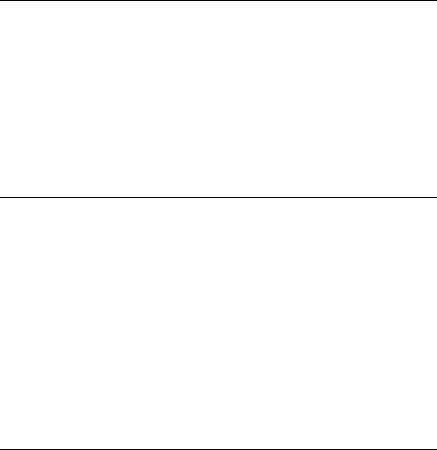
B CIRCUIT PROVISIONING
Caller ID Choices for Analog Lines 185
T1 Prerequisites |
186 |
|
|
T1 Recommendations |
186 |
|
|
ISDN PRI Prerequisites |
187 |
|
|
CSU Required |
187 |
|
|
ISDN PRI Recommendations |
187 |
||
ISDN BRI Prerequisites |
188 |
|
|
ISDN BRI Recommendations |
189 |
||
C GUIDELINES FOR CONNECTING REMOTE AUDIO DEVICES
Maximum Transfer Unit (MTU) 191 |
|
|
|||
Communication Latency Requirements |
192 |
|
|||
Large Packet Latency |
192 |
|
|
|
|
Small Packet Latency |
192 |
|
|
|
|
Bandwidth Requirements |
193 |
|
|
|
|
Layer 2 |
Mulaw (G.711) Audio (Normal Setting) 193 |
|
|||
Layer 3 |
Mulaw (G.711) Audio |
193 |
|
|
|
Layer 2 |
ADPCM Audio (Reduced Bandwidth Setting) |
193 |
|||
Layer 3 |
ADPCM Audio (Reduced Bandwidth Setting) |
193 |
|||
Notes on Bandwidth Requirements |
193 |
|
|||
Installing Fax Machines with ATAs |
194 |
|
|
||
D OBTAINING SUPPORT FOR YOUR 3COM PRODUCTS
Register Your Product to Gain Service Benefits |
195 |
Solve Problems Online 195 |
|
Purchase Extended Warranty and Professional Services 196 |
|
Access Software Downloads 196 |
|
Contact Us 196 |
|
Telephone Technical Support and Repair |
197 |
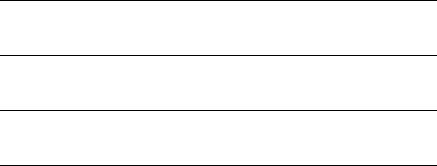
INDEX
FCC CLASS A VERIFICATION STATEMENT
INDUSTRY CANADA NOTICE
3COM END USER SOFTWARE LICENSE AGREEMENT TERMS AND CONDITIONS AND LIMITED WARRANTY
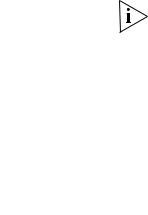
ABOUT THIS GUIDE
This guide provides information and instructions for installing the
SuperStack® 3 NBX® and the NBX® 100 Networked Telephony Solutions.
It is intended for authorized installation technicians.
■ If the information in the release notes differs from the information in this guide, follow the instructions in the release notes.
■ Release notes and all product technical manuals are available on the NBX Resource Pack CD and the 3Com Partner Access Web Site.
■ For information about monitoring, changing, and maintaining the
|
system, see the NBX Administrator’s Guide on the NBX Resource Pack |
|
|
CD or in the NBX NetSet interface. |
|
|
■ For information about using the telephones on an NBX system, see |
|
|
the NBX Telephone Guide and the NBX Feature Codes Guide on the |
|
|
NBX Resource Pack CD or in the NBX NetSet interface. |
|
|
|
|
How to Use |
Table 1 shows where to look for specific information in this guide. |
|
This Guide |
Table 1 Overview of the Guide |
|
|
|
|
|
|
|
|
Description |
Chapter |
|
|
|
|
An overview of the installation process and hardware components |
Chapter 1 |
|
|
|
|
How to install hardware components and telephone lines |
Chapter 2 |
|
|
|
|
How to install Telephones and Attendant Consoles |
Chapter 3 |
|
|
|
|
How to install Analog Line Cards |
Chapter 4 |
|
|
|
|
How to install Analog Terminal Cards and |
Chapter 5 |
|
Analog Terminal Adapters |
|
|
|
|
|
How to install BRI-ST Digital Line Cards |
Chapter 6 |
|
|
|
|
How to install E1 ISDN PRI Digital Line Cards |
Chapter 7 |
|
|
|
|
How to install T1 Digital Line Cards |
Chapter 8 |
|
|
|
|
How to configure IP telephony |
Chapter 9 |
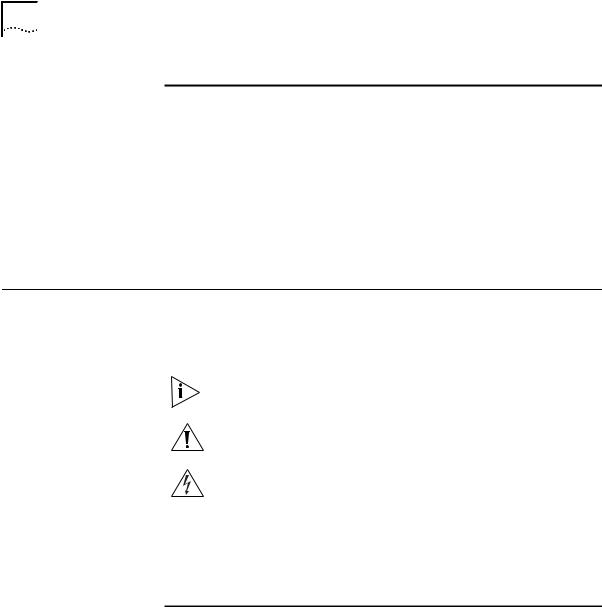
18 ABOUT THIS GUIDE
Table 1 Overview of the Guide (continued)
Description |
Chapter |
|
|
Troubleshooting information |
Chapter 10 |
|
|
System and component specifications |
Appendix A |
|
|
ISDN BRI, ISDN PRI, and T1 circuit provisioning information |
Appendix B |
|
|
Guidelines for connecting remote audio devices |
Appendix C |
|
|
Obtaining Support for Your 3Com Product |
Appendix D |
|
|
References to all topics in this book |
Index |
|
|
FCC, Industry Canada, Software License Agreement, and |
the last pages in |
Warranty information |
this book |
|
|
Conventions |
Table 2 lists conventions that are used throughout this guide. |
||
|
Table 2 |
Notice Icons |
|
|
|
|
|
|
Icon |
Notice Type |
Description |
|
|
|
|
|
|
Information note |
Information that describes important features |
|
|
|
or instructions |
|
|
|
|
|
|
Caution |
Information that alerts you to potential loss of data |
|
|
|
or potential damage to an application, device, |
|
|
|
system, or network |
|
|
|
|
|
|
Warning |
Information that alerts you to potential personal |
|
|
|
injury |
|
|
|
|
|
|
|
|
International |
Table 3 lists the United States and international equivalents of some of |
Terminology |
the specialized terms used in the NBX documentation. |
|
Table 3 International Terminology |
Term used in U.S. |
Term used outside the U.S. |
|
|
Toll restrictions |
Call barring |
|
|
Pound key (#) |
Hash key (#) |
|
|
CO (central office) |
Telephone Exchange |
|
|
Toll-free |
Free-phone |
|
|
Analog Line Card |
Analog Trunk Line Interface Module |
|
|

Your Comments on the Technical Documentation 19
Your Comments on Your suggestions are important to us. They help us to make the NBX the Technical documentation more useful to you.
Documentation
Send comments about this guide or any of the 3Com NBX documentation and Help systems to:
Voice_TechComm_Comments@3com.com
Include the following information with your comments:
■Document title
■Document part number (found on the front page)
■Page number
■Your name and organization (optional)
Example:
NBX Installation Guide
Part Number 900-0131-01 Rev AB
Page 20
As always, address all questions regarding the NBX hardware and software to your 3Com NBX Voice-Authorized Partner.

20 ABOUT THIS GUIDE

INTRODUCTION
1
The NBX® Networked Telephony Solution comprises these parts:
■An NBX Call Processor
■A chassis with removable cards
■Optionally, one or more additional chassis
■One or more 3Com telephones
■Optionally, one or more analog devices such as fax machines or third-party telephones
■Optionally, one or more 3Com Attendant Consoles
This chapter describes NBX hardware and software in these topics:
■SuperStack 3 NBX Core Components
■NBX 100 Core Components
■Overview of NBX Cards and Devices
■Overview of Application Software
■System Configuration Guidelines
For information about how to prepare your site and how to choose the appropriate system components, see the NBX System Planning Guide on the NBX Resource Pack CD or on the 3Com Partner Access web site.
For information about configuring the Dial Plan and maintaining your NBX system, see the NBX Administrator’s Guide in the NBX NetSet™ utility, on the NBX Resource Pack CD, or on the 3Com Partner Access web site.
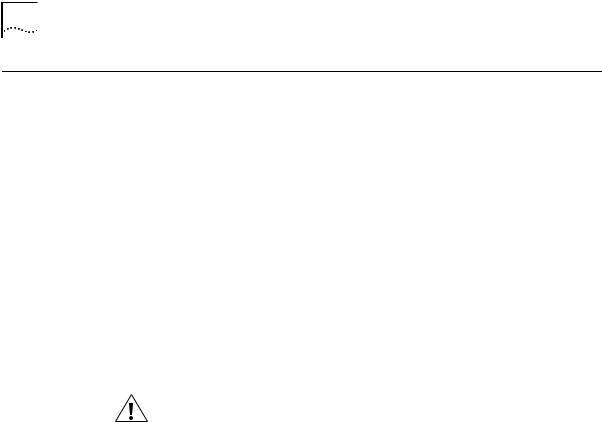
22 CHAPTER 1: INTRODUCTION
SuperStack 3 NBX |
The core components are the Call Processor and one or more Gateway |
Core Components |
chassis. |
SuperStack 3 NBX Call The SuperStack 3 NBX Call Processor (Figure 1) contains the system Processor power supplies, cooling fans, and one disk drive. Optionally, you can add
a second “mirrored” disk drive. (Disk mirroring is described in the NBX Administrator’s Guide in the NBX NetSet™ utility, on the NBX Resource Pack CD, or on the 3Com Partner Access web site.)
The Call Processor manages call traffic, voice mail, and the Automated Attendant. It can be licensed for up to 1500 devices. See “System Configuration Guidelines” on page 47 for more information on the total number of supported devices.
A SuperStack 3 NBX system is available in these base models:
■With a single power supply and licensed for 250 devices
■With redundant power supplies and licensed for 250 devices
CAUTION: Each of the two power supply units in the redundant model has its own overcurrent protection device. That is, the overcurrent device for one power supply does not protect the second power supply. You must connect two AC power cords to the unit to power both of the power supplies.
A SuperStack 3 NBX system includes these features:
■Supports the Telephony Application Programming Interface (TAPI) 2.X for Computer Telephony Integration (CTI) applications
■Includes a web server to support the NBX NetSet administration utility
■Includes an Internet Message Access Protocol (IMAP4) message server for integration of voice mail and e-mail
The SuperStack 3 NBX Call Processor has these connectors and LEDs, shown in Figure 1:
■VOL — This adjusting screw controls the volume of Music On Hold.
■MOH — This mini-jack (mono or stereo) accepts music-on-hold audio from the line output of a CD player, tape player, or other music source.
■PAGING — This RJ-11 connector provides an audio output or a dry contact switch connection for use with a public address system.
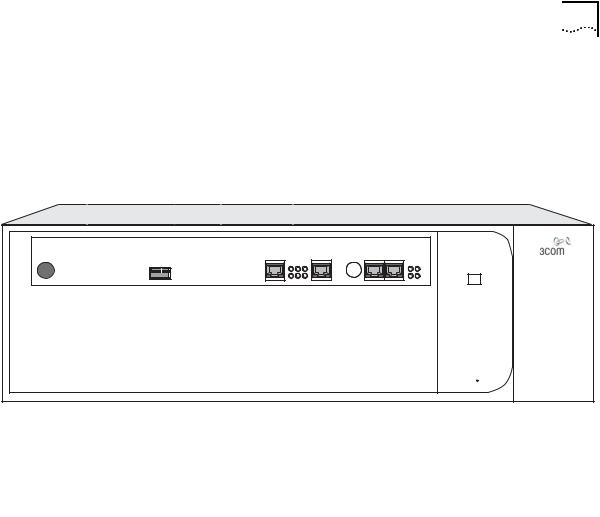
SuperStack 3 NBX Core Components 23
■EXTERNAL ALERT — Reserved for future use.
■Status Lights (LEDs) — Status lights indicate power, initialization, system status, and drive activity. See Figure 30 on page 51 for details.
Figure 1 Front Panel of the SuperStack 3 NBX Call Processor
|
|
1 |
|
2 |
3 |
|
4 |
|
|
|
|
|
|
|
|
|
|
|
|
|
|
|
NBX Call Processor |
|
|
|
|
|
|
|
|
V |
|
|
External |
|
Mouse |
|
USB |
Com 1 |
Com 2 |
Ethernet 1 |
Ethernet 2 |
o |
MOH |
Paging |
|
KYBD |
Video |
l |
Alert |
||||||||
|
|
|
|
|
|
|
|
|
|
|
SuperStackR 3 NBX |
1NCP Board Nonremovable Call Processor with connections and ports
2Disk Drive 0 By factory default, the location of the Primary Drive
3Disk Drive Shipped with the primary drive installed on the left
Tray
4Disk Drive 1 Position where you can add the optional secondary disk
drive
For installation instructions, see Chapter 2.

24 CHAPTER 1: INTRODUCTION
SuperStack 3 NBX The NBX Gateway Chassis (1 in Figure 2) contains four universal card Gateway Chassis slots. As shipped from the factory, the top three have faceplates and the
fourth is left open. For installation instructions, see Chapter 2.
Figure 2 SuperStack 3 NBX Gateway Chassis (Front)
1 |
2 3 |
|
10M Shared |
|
Power |
|
Partition |
|
Link/Activity |
|
10/100M Switched |
|
Activity |
|
10M Link |
|
100M Link |
|
10/100M Switched |
|
Activity |
|
10M Link |
|
100M Link |
|
3C10200 NBX Gateway Chassis |
1 |
4-slot chassis |
Removable faceplates installed |
2 |
10/100 Mbps switched Ethernet |
Two redundant uplink ports |
|
connection |
|
3 |
10 Mbps shared Ethernet |
One port |
|
connection |
|
|
|
|
A single SuperStack 3 NBX Call Processor can support up to 25 NBX
Gateway Chassis.
Use the upper 10/100 uplink port on each Gateway Chassis (shown at the top of the bracket labeled 2) to connect to the LAN. The lower port is normally inactive and becomes active only if the upper port experiences a link failure.
You must use straight-through Ethernet cable connections; you cannot use MDI/MDIX connections.
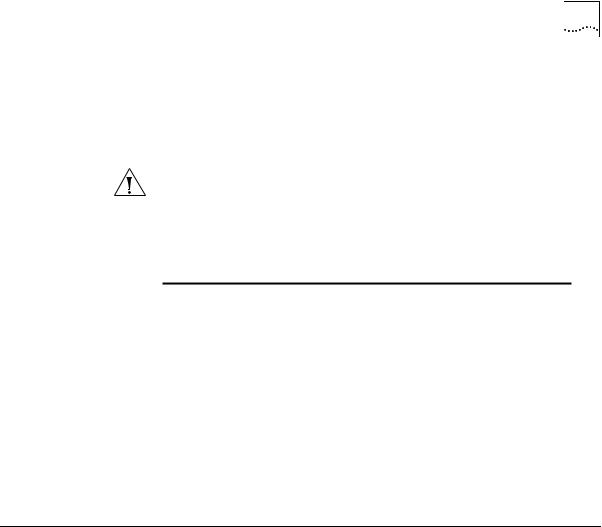
NBX 100 Core Components 25
Redundant Power Supply
You can attach a redundant power supply to the RPS connector on the back of the NBX Gateway Chassis. Table 4 describes the items that you must purchase, assemble, and connect to the chassis. See your 3Com NBX Voice-Authorized Partner for purchasing details.
CAUTION: If you are using the 3Com SuperStack II ARPS (Advanced
Redundant Power Source) as a backup power supply for the NBX
Gateway Chassis, you can have no more than 2 Analog Terminal Cards of
Models 3C10117, 3C10117A, or 3C10117B-INT per Gateway Chassis.
This restriction does not apply to the 3C10117C Analog Terminal Card.
Table 4 Items in the Redundant Power Supply
Order Number |
Description |
Quantity |
|
|
|
3C16071B |
SuperStack II ARPS Chassis |
1 |
|
|
|
3C16074A |
Type 2A, 100W Power Module (NLP100-9640) |
2 |
|
|
|
3C16078 |
Type 2 “Y” Cable |
1 |
|
|
|
To connect the redundant power supply to the NBX Gateway Chassis:
1Assemble the redundant power supply according to the instructions in the SuperStack II ARPS documentation.
2Attach the “Y” cable to the RPS connector on the back of the NBX Gateway Chassis.
3Connect the SuperStack II ARPS chassis to a source of AC power.
NBX 100 Core |
The heart of the NBX 100 Communications System is the Network Call |
Components |
Processor card. It and other removable cards sit in the 6-Slot Chassis. |
NBX 100 6-Slot The NBX 100 6-Slot Chassis, shown in Figure 3, holds the system power Chassis supply, disk drive, cooling fans, and removable cards, including the
NBX 100 Call Processor.
All controls and connections are on the front of the chassis. The chassis fits into a standard 19-inch equipment rack, or it can be wall-mounted or placed on a table.
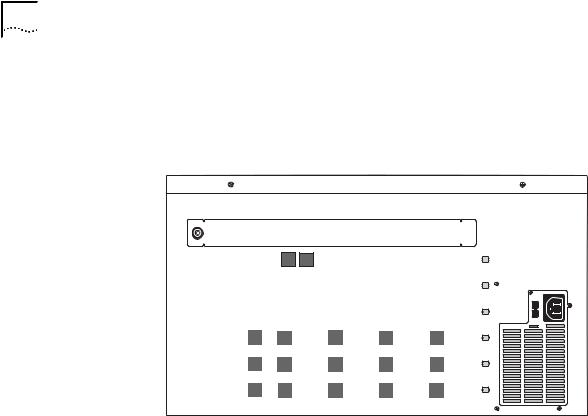
26 CHAPTER 1: INTRODUCTION
An NBX 100 system can have one or more chassis. The number depends on how many external telephone lines the system must support and the equipment that you choose for attaching telephones. Additional chassis must not contain an NBX Call Processor card.
Figure 3 NBX 100 Chassis with Call Processor and Cards
S |
S |
S |
V |
MOH |
PAGING EXT. ALERT |
10BT UPLINK |
COM 1 |
COM 2 |
|
|
|
|
|
||||
1 |
2 |
3 |
O |
|
|
|
|
|
|
|
|
L |
|
|
|
|
|
3C10110D 3Com NBX Call Processor |
|
|
|
MDI-X |
|
|
||
PWR |
1 |
2 |
3 |
4 |
5 |
6 |
7 |
8 |
|
|
|
|
|
|
|
|
|
1 |
8 |
3C10370 3Com NBX Uplink Card
|
|
|
|
|
|
CF |
10BT UPLINK |
|
|
|
|
|
|
CONSOLE |
|
|
|
|
|
|
|
RA |
|
|
|
|
T1 |
|
|
|
|
3C10116C 3Com NBX Digital Line Card |
|
|
Nominal |
MDI-X |
|||
|
|
LB |
|||||
|
|
|
|||||
1 |
2 |
3 |
4 |
|
|
|
|
|
|
|
PFT |
1 |
2 |
3 |
4 |
NBX 100
|
115 volts |
115 |
230 |
230 volts |
|
3C10114C 3Com NBX Analog Line Card
1 2 3 4
PFT |
1 |
2 |
3 |
4 |
3C10114C 3Com NBX Analog Line Card
1 2 3 4
PFT |
1 |
2 |
3 |
4 |
3C10114C 3Com NBX Analog Line Card
Up to six cards slide into the front of the chassis. An internal backplane connects the cards to each other.
The top slot has no access to the backplane. Always cover the top slot with a blank faceplate.
The Network Call Processor, interface cards, and devices are described later in this chapter.
For installation instructions, see Chapter 2.
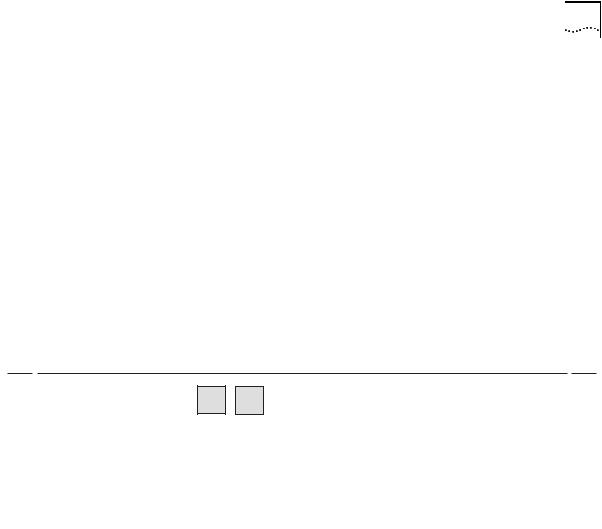
NBX 100 Core Components 27
NBX 100 Call The top active slot in the primary NBX 100 chassis holds the NBX 100 Call Processor Processor. The NBX 100 Call Processor:
■Manages call traffic, voice mail, and the Automated Attendant
■Supports the Telephony Application Programming Interface (TAPI) 2.X for Computer Telephony Integration (CTI) applications
■Includes an Internet Messaging Access Protocol 4 (IMAP4) message server for integration of voice mail and e-mail and a web server to support web-based system administration
■Supports all NBX line cards
■Supports up to 200 devices. See “System Configuration Guidelines” on page 47 for the rules about supported devices.
There are two versions of the NBX 100 Call Processor, shown in Figure 4 and Figure 5.
Figure 4 NBX 100 Call Processor (3C10110C)
S |
S |
S |
V |
MOH |
PAGING |
EXT. ALERT |
10BT UPLINK |
COM 1 |
COM 2 |
|
|
|
|
|
|
||||
O |
|
|
|
|
|
|
|||
1 |
2 |
3 |
|
|
|
|
|
|
|
|
|
|
L |
|
|
|
|
|
|
3C10110C 3Com NBX Call Processor |
|
|
|
BNC 10B2 |
MDI-X |
|
|
||
Figure 5 NBX 100 Call Processor (3C10110D) |
|
|
|
||||||
S |
S |
S |
V |
MOH |
PAGING |
EXT. ALERT |
10BT UPLINK |
COM 1 |
COM 2 |
|
|
|
|
|
|
||||
O |
|
|
|
|
|
|
|||
1 |
2 |
3 |
|
|
|
|
|
|
|
L |
|
|
|
|
|
|
|||
|
|
|
|
|
|
|
|
|
|
3C10110D 3Com NBX Call Processor |
|
|
|
|
MDI |
|
|
||
|
|
|
|
|
|
|
|
|
|
The difference between the 3C1011C and the 3C1011D is that the 3C10110C Network Call Processor includes a BNC connector for uplink connections.
The NBX 100 Call Processor has these status lights and connectors:
■Status Lights — The three status lights (S1, S2, and S3) indicate:
S1 and S2 — Indicate operating system status.
■If S1 and S2 are both flashing (approximately 2 flashes per second), the hardware is initializing.
■If S1 is on and S2 is off, the operating system has started successfully.

28 CHAPTER 1: INTRODUCTION
■If S1 and S2 are both on, the operating system software has not started successfully.
■If S1 and S2 flash in an alternating pattern, a file system check is in progress, possibly due to an improper shutdown, and the boot process will take longer than normal.
S3 — Indicates the status of music on hold (MOH).
■If S3 is flashing (approximately 2 flashes per second), the music on hold processor is initializing. If this flashing continues for more than 2 minutes, the processor has not started successfully.
■If S3 is on, the MOH processor has started successfully.
■If S3 is flashing slowly (approximately 1 second on and 1 second off), the MOH processor has started successfully, but no music source is connected.
■VOL-MOH — This mini-jack (mono or stereo) accepts Music-On-Hold audio from a CD player, tape player, or other music source. The adjusting screw next to the jack controls the volume.
■PAGING — This RJ-11 connector provides an audio output or a dry contact switch connection for use with a public address system.
■EXT ALERT — This RJ-11 connector is reserved for future use.
■10BT UPLINK — This connector provides means to connect to an external Ethernet switch or hub.
The 3C10110C Network Call Processor includes a BNC connector for uplink connections. The BNC and RJ-45 uplink connectors are alternative connections for a single port. They cannot be used simultaneously.
If you use the Uplink connector, be sure to program the switch or router on the other end for 10BASE-T 10 MB operation.
■COM1 — The COM1 connector provides a DTE (Data Terminal Exchange) connection for use with a VT100-compatible control terminal. This connection provides command line access to the Call Processor’s operating system and diagnostic commands.
■COM2 — Reserved for future use.
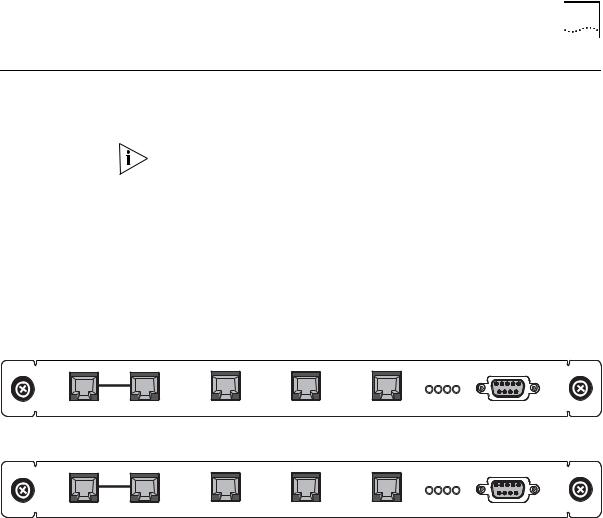
Overview of NBX Cards and Devices 29
Overview of NBX This section lists all of the NBX devices that can be used with either the Cards and Devices SuperStack 3 NBX or the NBX 100 system. Not all cards may be available
in every region.
Before you install any Analog Line Cards or Digital Line Cards, you may want to configure the Dial Prefix settings. For information on this topic, see “Dial Prefix Settings” in Chapter 2 in the NBX Administrator’s Guide or the NBX NetSet Help at Dial Plan > Operations > Dial Prefix Settings.
Analog Line Card The NBX Analog Line Card connects up to four analog telephone lines to the NBX system. The SuperStack 3 NBX system can support up to 180 line cards (720 CO telephone lines) using multiple NBX Gateway chassis. The NBX 100 system can support up to 25 line cards (100 CO telephone lines) using multiple NBX 100 chassis.
Figure 6 NBX Analog Line Card (3C10114)
PFT |
1 |
3C10114 3Com NBX Analog Line Card
2 |
3 |
4 |
|
|
CONSOLE |
|
|
|
|
1 |
2 |
3 |
4 |
Figure 7 NBX Analog Line Card (3C10114C)
PFT |
1 |
3C10114C 3Com NBX Analog Line Card LS
2 |
3 |
4 |
|
|
CONSOLE |
|
|
|
|
1 |
2 |
3 |
4 |
Functionally, 3C10114 and 3C10114C are identical. However, 3C10114C uses some different internal components so that 3C10114C requires NBX software release R4.1 or higher.
Each Analog Line Card contains the following lights and connectors:
■Status Lights (1 through 4) — Each light shows the status of the associated line.
Initialization (prior to Release R4.1):
■All four lights flash in unison – Hardware is initializing.
■A light flashes on twice, off for 2 seconds – Associated port has been initialized successfully.

30 CHAPTER 1: INTRODUCTION
Initialization (Release R4.1 and higher):
■Fast steady blink – Waiting for software download.
■Solid on – Software has been downloaded. The flash memory on the board is being loaded.
■Slow, non-symmetric blinking pattern – Waiting for the completion of the binding process to the call processor.
Operation:
■Off for 9 to 10 seconds, on briefly – Idle, the line is not in use.
■On for 9 to 10 seconds, off briefly – A telephone call is connected on this port.
■Console Connector — This DB-9 connector provides an RS-232 (DCE) TTY terminal connection for maintenance access.
T1 Digital Line Card The T1 Digital Line Card is an optional card that lets you connect a T1 line to the NBX system. The SuperStack 3 NBX system can accommodate up to 30 T1 Digital Line Cards (720 channels) if they are configured for DS1 operation, and 31 T1 Digital Line Cards (713 channels) if they are configured for ISDN PRI operation. The NBX 100 system can accommodate up to 3 T1 Digital Line Cards (72 channels if the cards are configured for DS1 operation or 69 channels if the cards are configured for ISDN PRI operation), if you connect them using MDI-X ports. If you connect a T1 Digital Line Card using the NBX 100 system backplane, the system can accommodate only one card.
All digital line cards require NBX system software Release R2.6 or higher.
The 3C10116D T1 Digital Line Card requires NBX system software Release
R4.3 or higher.
You must have an external Channel Service Unit (CSU) when using the 3C10116C T1 Digital Line Card. 3C10116D includes an onboard CSU. The 3C10116D can provide CSU performance statistics, supports loopback testing, and can be configured as a remote device that communicates with its NCP over a routed network.
When configured as standard T1 (DS1), the T1 card supports in-band signaling of 24 DS0 (64 Kbps) “voice” channels and a variety of signaling types and protocols. The T1 carries data at a rate of 1.544 Mbps. When configured as ISDN PRI, the T1 card supports 23 voice channels with PRI services such as Direct Inward Dialing (DID).
